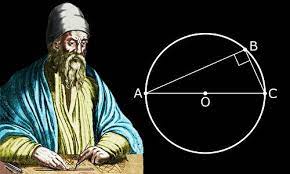
Quick Info
Born
about 325 BC
(probably) Alexandria, Egypt
Died
about 265 BC
Alexandria, Egypt
Summary
Euclid, a renowned Greek mathematician, is most celebrated for his seminal work in geometry known as “The Elements.” This influential treatise has left an indelible mark on the progression of Western mathematics, shaping its course for over two millennia.
Biography
Euclid of Alexandria, an ancient Greek mathematician, is renowned for his magnum opus in mathematics, “The Elements.” This enduring work has had an unparalleled impact, serving as the cornerstone of mathematical education for over two millennia. While historical information about Euclid’s life remains scarce, it is widely accepted that he taught in Alexandria, Egypt.
Proclus, a prominent Greek philosopher from around 450 AD, referred to Euclid in his writings, suggesting that Euclid compiled “The Elements” by organizing the theorems of Eudoxus, refining those of Theaetetus, and rigorously demonstrating concepts that had been loosely proven by his predecessors. Euclid is believed to have lived during the time of the first Ptolemy, a period when Archimedes, another renowned mathematician, mentioned him. A famous anecdote recounts Ptolemy asking Euclid if there was a shortcut to mastering geometry, to which Euclid famously replied that there is no “royal road” to geometry.
Regarding Euclid’s personal history, various accounts exist, but some are considered unreliable. Arab authors, for instance, claimed that Euclid was the son of Naucrates and born in Tyre. However, most historians dismiss these claims as fictitious. There’s also confusion about his birthplace, with some sources erroneously suggesting Megara as his birthplace. In reality, there was a philosopher named Euclid of Megara, who lived approximately a century before the mathematician Euclid of Alexandria, and the shared name complicates efforts to discern information about the latter.
Several hypotheses exist regarding Euclid’s life and authorship of “The Elements.” One hypothesis posits that Euclid was a historical figure who authored “The Elements” and other attributed works. Another suggests that he led a team of mathematicians in Alexandria who collectively produced the “complete works of Euclid.” A third hypothesis proposes that Euclid was not a real person, but rather, a pseudonym used by a group of mathematicians who took inspiration from Euclid of Megara.
The prevailing belief among historians is that Euclid was indeed a historical figure (hypothesis i). While it’s plausible that he had capable students who contributed to his works, concrete evidence for hypothesis ii is scarce. Hypothesis iii, although seemingly far-fetched, is not impossible, as evidenced by the 20th-century example of the Bourbaki group in mathematics.
Assuming the first hypothesis to be true, Euclid likely studied at Plato’s Academy in Athens, where he acquired knowledge of the geometry of Eudoxus and Theaetetus. Notably, none of Euclid’s works contain prefaces, making it challenging to discern his personality or intentions from the texts themselves. Nevertheless, historical accounts describe him as a fair, accommodating scholar who was not boastful despite his exacting scholarship.
Euclid’s most renowned work, “The Elements,” comprises 13 books. The first six deal with plane geometry, covering topics such as triangles, parallels, circles, and proportions. Books seven to nine delve into number theory, including the Euclidean algorithm for finding the greatest common divisor of two numbers. Book ten addresses irrational numbers. The final three books explore three-dimensional geometry, discussing topics like the properties of circles, spheres, and the five regular polyhedra.
Euclid’s Elements are highly regarded for their clarity and rigor. The standards of precision set by Euclid became a benchmark for mathematical reasoning and influenced future mathematical developments, including the invention of calculus.
In addition to “The Elements,” Euclid authored other works that have survived, including “Data,” “On Divisions,” “Optics,” and “Phaenomena.” However, several of his works, such as “Surface Loci,” “Porisms,” “Conics,” “Book of Fallacies,” and “Elements of Music,” have been lost over time.
Euclid’s enduring legacy as a mathematician and educator is evident in the countless editions and translations of “The Elements” published since its first printing in 1482. It has remained a cornerstone of mathematical education and a testament to Euclid’s lasting influence on the field.


